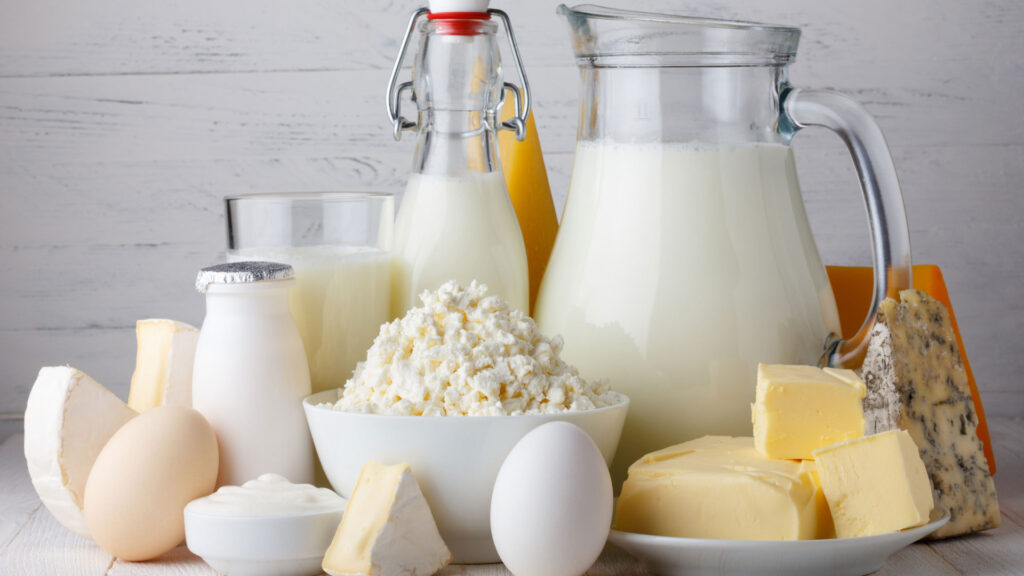Dairy foods offer essential nutrients that contribute to overall well-being, but can also add a healthy dose of good bacteria, known as probiotics, that can keep your gut healthy and add a myriad of other healthy contributions. From tangy yogurt and savory cheese, there are numerous options to find good bacteria in the dairy aisle.
Probiotics are live organisms (bacteria, yeasts, and fungi) that are used to make fermented foods. Fermenting foods preserves them, using an age-old process of controlled microbial growth.1 Probiotics are sometimes called good bacteria because they can have beneficial effects on our bodies.2 Not only do probiotics help boost the food’s shelf life, they also increase their nutritional value and can be crucial to good digestion and gut health.3
Sometimes, the terms fermented foods and probiotics are used interchangeably. Not all living micro-organisms in fermented foods and beverages, however, are categorized as probiotics. The term probiotics is applicable only when there is an established health benefit due to the presence of these live microorganisms. If fermented products are heat treated, the beneficial bacteria will be destroyed. Therefore, look for the words “contains live and active cultures” or a similar statement on the label to be sure you’re getting the good bacteria in the product.4 (Note: Aged, but not heated, cheeses may contain probiotics, however, there are no specific regulations regarding probiotic labeling on cheeses.)4
Nutrient-Rich Dairy
Dairy products (milk, yogurt, and cheese5*) have long been celebrated for their rich nutrient profile and numerous health benefits. When choosing dairy, it’s important to incorporate a variety of products in appropriate portion sizes. Individuals nine years and older should consume about three cups of dairy each day.5 Check the MyPlate Cup of Dairy Table to see what counts as a cup equivalent of dairy.6 Dairy provides the best benefits when consumed in low-fat or fat free versions. Some of the nutrients found in dairy products include:
- Rich Source of Calcium: Dairy products are known for their high calcium content, crucial for maintaining strong bones7 and teeth.8 Adequate calcium intake is important for preventing osteoporosis and promoting bone health throughout life.
- Protein Power: Yogurt, kefir, cheese, and milk are excellent sources of high-quality protein, vital for muscle repair, growth, and overall body function. Protein from dairy products contains all essential amino acids, making it a complete protein source.
- Vitamin D Boost: Many dairy products are fortified with vitamin D, essential for calcium absorption and bone health.9 Adequate vitamin D levels also support immune function and reduce the risk of chronic diseases.
- Other Essential Nutrients: In addition to calcium and vitamin D, dairy products provide essential nutrients such as phosphorus, potassium, magnesium, zinc, and vitamins A, B12, and riboflavin, which are integral for various bodily functions.10
*Note: Cream, sour cream, and cream cheese are not included in the dairy foods group due to their low calcium content.5
Get the Most Bang for Your Gut
Let’s delve into the healthy aspects of incorporating probiotic dairy into your diet. Some popular and healthful fermented dairy foods include yogurt, kefir, cheese, and fermented milks.
Yogurt
Yogurt is a probiotic-rich food that supports gut health by promoting the growth of beneficial bacteria.11,12 Research suggests that consuming yogurt regularly may improve digestion, enhance immune function, and reduce the risk of certain digestive disorders. Both regular and Greek yogurt can be healthy options. Greek yogurt, in particular, contains higher amounts of protein and lower carbohydrates, when compared to regular yogurt. Greek yogurt is produced like regular yogurt (by the bacterial fermentation of milk), but at the end of the process the whey is strained out, making the yogurt thicker, tangier, and lower in carbohydrates than regular yogurt. Therefore, nonfat Greek yogurt is a great option for those who are counting their carbohydrates. While not lactose-free, Greek yogurt may also be more tolerable for people with lactose intolerance since some of the lactose (naturally occurring sugar in milk) is removed in the straining process.13 Beware of added sugar in flavored yogurts of any kind. Opt for plain, unsweetened yogurt (regular or Greek) for maximum health benefits. Stir or blend in fresh fruit for more flavor options. Add some nuts, flax seeds, or chia seeds as toppings for extra fiber and omega-3 fatty acids, and antioxidants.
Kefir
Kefir is a fermented dairy (milk) beverage rich in probiotics and nutrients.14 Kefir is made by adding kefir grains, which contain yeast and good bacteria, to milk.15 Kefir’s nutritional benefits vary based on what type of milk it contains (cow, goat, or sheep’s milk) and by the fermenting process; but, it generally contains more strains of probiotics and beneficial yeast than yogurt, and offers similar gut health benefits.1 Though creamy like yogurt, kefir has a more sour, tangy flavor. Kefir is also low in lactose (milk sugar) and may be more tolerable for people with lactose intolerance than regular yogurt.14 Like yogurt, kefir comes in plain and flavored varieties (check the Nutrition Label for added sugar content). It’s best to opt for plain kefir and add in fresh fruit for flavor variety.
Cheese
Certain types of cheese contain probiotics, too, which can foster good bacteria in your gut. Typically, these are cheeses that have been aged, but not heated (pasteurized) afterward (because heat would kill the live bacteria).15 This includes both hard and soft cheeses.16 Some examples of cheeses that may include probiotics are caciocavallo, cheddar, cottage cheese, Edam, feta, Gouda, Gorgonzola, Gruyere, mozzarella, Parmesan, provolone, and Swiss.16,17,18 Cheese is also rich in calcium and protein,9,17 but moderation is key because cheese can be high in calories, saturated fat, and salt.17 Still, incorporating small servings into your diet can provide valuable nutrients and a boost in taste and texture.
Fermented milks (acidophilus milk & buttermilk)
While many probiotic-rich foods are made from milk, milk alone (cow’s milk or non-bovine milk) does not contain probiotics. A couple of exceptions are acidophilus milk and buttermilk. Acidophilus milk is milk that has been specially fermented with live bacteria cultures. It is labeled acidophilus milk because it’s fermented by the bacteria Lactobacillus acidophilus.19,20 Buttermilk is another fermented dairy product. Buttermilk doesn’t contain butter; it is the liquid leftover after the churning of milk into cream to make butter. What you mostly find in the grocery today is cultured buttermilk, which is milk (often low-fat milk) cultured by adding live lactic acid bacteria.21.22 With these milk products it’s important to look at the labeling to note whether it is made with “live active cultures” to be sure you’re getting the probiotics for which you’re looking.
Incorporate Dairy Deliciously
Here are some tasty tips for adding probiotic-rich dairy products to your diet deliciously:
- Smoothie Boost: Blend yogurt or kefir into your morning smoothie for a creamy texture and a probiotic punch. Add in fruits and leafy greens (e.g. a handful of spinach) for an extra nutrient boost.
- Breakfast bowl: Start your day simply with a breakfast bowl. Choose your favorite whole grain cereal (without added sugar) topped with kefir or yogurt and sliced fruit; or choose a bowl of Greek yogurt topped with fresh fruit, nuts, or granola (without added sugar) for a nourishing and protein-packed breakfast.
- Creamy Dressings and Dips: Use Greek yogurt or plain kefir as a base for homemade salad dressings and dips. Mix with herbs, spices, and lemon juice for a tangy and nutritious alternative to store-bought options.
- Oatmeal Upgrade: Add a dollop of yogurt into your morning oats for added creaminess and protein. Top with sliced fruits, nuts, and a drizzle of kefir for a satisfying breakfast, or even for lunch.
- Cheese Pairings: Pair reduced-fat soft cheese like cottage cheese with whole grain crackers, fresh fruits, or vegetables for a satisfying snack or appetizer. Use aged, harder, or more pungent cheese, like parmesan, Swiss, or sharp cheddar, for a big boost of flavor in small amounts atop salads, soups, stews, or incorporated into sandwiches or omelets.
- Yogurt Parfaits: Layer Greek yogurt with granola and berries for a delicious and nutritious parfait that’s perfect for breakfast or as a dessert option.
- Creamy Soups: Add a splash of kefir or a dollop of yogurt to homemade soups and stews for added richness and creaminess.
- Frozen Treats: Freeze yogurt in ice cube trays or popsicle molds for a refreshing and nutritious frozen treat. Add in fruits, nuts, or nut butters for extra nutrients and flavor.
- On-the-go Option: Need something on-the-go, grab an 8-ounce (1 cup) bottle of plain kefir and add a splash of orange juice (or other 100% fruit juice) for added flavor.
Dairy Alternatives
While probiotic dairy products offer numerous health benefits, some individuals may experience lactose intolerance or dairy allergies, necessitating alternative options.10 Fortified soy beverages and soy yogurt are recommended alternatives because they are similar to milk and yogurt in nutrient content.6 Soy beverages are the only milk alternative that closely matches the nutrient profile of dairy milk, providing comparable amounts of protein, calcium, and other essential nutrients.
Make Your Way to the Dairy Aisle
So, make your way to the dairy aisle and discover the health benefits. When consumed as part of a balanced diet, fermented dairy products with good bacteria can be valuable sources of essential nutrients, including calcium, protein, and vitamins, which contribute to overall health and well-being.23 Incorporating a variety of options, like yogurt, kefir, and small amounts of some cheeses can enhance gut health and provide diverse nutritional benefits. Nevertheless, mindful consumption, like opting for reduced-fat varieties and being aware of added sugars and sodium, is crucial for maximizing the healthful aspects of dairy in your diet.
Infographic
Download the PDF or share the image below to help others learn more about probiotics a good bacteria in the dairy aisle.
Probiotics: Good Bacteria in the Dairy Aisle – Infographic (pdf)
- Dimidi E, Cox SR, Rossi M, Whelan K. Fermented Foods: Definitions and Characteristics, Impact on the Gut Microbiota and Effects on Gastrointestinal Health and Disease. Nutrients. 2019 Aug 5;11(8):1806. https://doi.org/10.3390/nu11081806.
- Cleveland Clinic What are probiotics & what do they do? Cleveland Clinic. October 30, 2023. Accessed February 16, 2024. https://my.clevelandclinic.org/health/treatments/14598-probiotics.
- Harvard University. Fermented foods can add depth to your diet. Harvard Health. April 19, 2021. Accessed February 16, 2024. https://www.health.harvard.edu/staying-healthy/fermented-foods-can-add-depth-to-your-diet.
- Webb D. Probiotics in cheese – today’s Dietitian Magazine. Today’s Dietitian. March 2022. Accessed February 16, 2024. https://www.todaysdietitian.com/newarchives/0322p14.shtml.
- U.S. Department of Agriculture and U.S. Department of Health and Human Services. (2020). Dietary Guidelines for Americans, 2020-2025. https://www.dietaryguidelines.gov/sites/default/files/2020-12/Dietary_Guidelines_for_Americans_2020-2025.pdf.
- U.S. Department of Agriculture. USDA MyPlate Dairy Group – One of the Five Food Groups. Accessed February 16, 2024. https://www.myplate.gov/eat-healthy/dairy.
- Rizzoli R. Dairy products and Bone Health. Aging clinical and experimental research. January 2022. Accessed February 16, 2024. https://www.ncbi.nlm.nih.gov/pmc/articles/PMC8794967/.
- Li, A., Ma, Y., Cui, N., Zhang, X., Zheng, Q., Du, P., Sun, M. Research progress of milk and dairy products to prevent caries, Journal of Functional Foods,Volume 110, 2023, https://doi.org/10.1016/j.jff.2023.105837.
- Polzonetti V, Pucciarelli S, Vincenzetti S, Polidori P. Dietary Intake of Vitamin D from Dairy Products Reduces the Risk of Osteoporosis. Nutrients. 2020 Jun 10;12(6):1743. https://doi.org/10.3390/nu12061743.
- Thorning TK, Raben A, Tholstrup T, Soedamah-Muthu S, Givens I, & Astrup A. (2016). Milk and Dairy Products: Good or Bad for Human Health? An Assessment of the Totality of Scientific Evidence. Food & Nutrition Research, 60(1), 32527. https://doi.org/10.3402/fnr.v60.32527.
- Alvaro E, Andrieux C, Rochet V, et al. Composition and metabolism of the intestinal microbiota in consumers and non-consumers of yogurt. British Journal of Nutrition. 2007;97(1):126-133. https://doi.org/10.1017/S0007114507243065.
- Markowiak P, Śliżewska K. Effects of Probiotics, Prebiotics, and Synbiotics on Human Health. Nutrients. 2017; 9(9):1021. https://doi.org/10.3390/nu9091021.
- Hannah Magee R. Greek yogurt vs regular yogurt: A dietitian explains. Hannah Magee RD. November 3, 2022. Accessed February 16, 2024. https://hannahmageerd.com/greek-yogurt-vs-regular-yogurt-whats-the-difference/.
- Shetty N. What is kefir? A comprehensive guide to its health benefits. PharmEasy Blog. January 24, 2024. Accessed February 16, 2024. https://pharmeasy.in/blog/what-is-kefir-a-comprehensive-guide-to-its-health-benefits/.
- Cleveland Clinic. Is cheese good for you? Cleveland Clinic. February 7, 2024. Accessed February 16, 2024. https://health.clevelandclinic.org/is-cheese-good-for-you.
- Cleveland Clinic. Is drinking kefir good for you? Cleveland Clinic. December 18, 2023. Accessed February 16, 2024. https://health.clevelandclinic.org/benefits-of-kefir.
- Johns Hopkins Medicine. Five protein-packed foods for healthy, meatless meals. January 28, 2022. Accessed February 16, 2024. https://www.hopkinsmedicine.org/health/wellness-and-prevention/5-protein-packed-foods-for-healthy-meatless-meals.
- Harvard Health. Is cheese a healthy source of probiotics? July 18, 2023. Accessed February 16, 2024. https://www.health.harvard.edu/staying-healthy/is-cheese-a-healthy-source-of-probiotics.
- Saranraj P, Sudhanshu S, Behera s, Ray CR. Chapter 7 – Traditional Foods From Tropical Root and Tuber Crops: Innovations and Challenges, Galanakis CM, ed. Innovations in Traditional Foods, Woodhead Publishing, 2019,Pages 159-191, https://doi.org/10.1016/B978-0-12-814887-7.00007-1.
- Surono IS, Hosono A. Fermented Milk: Types and Standards of Identity, Fuquay JW, eds. Encyclopedia of Dairy Sciences (Second Edition), Academic Press, 2011,Pages 470-476, https://doi.org/10.1016/B978-0-12-374407-4.00180-1.
- Kumar R, Garsa AK, Kaur M, Shrivastava B. Natural and Cultured Buttermilk in Fermented milk and dairy products. Puniya AK, ed., CRC Press/ Taylor and Francis, USA , May 2015, Pages 203-225. Accessed February 16, 2024. https://www.researchgate.net/publication/280136366_Natural_and_Cultured_Buttermilk.
- Live Science. What is buttermilk? May 14, 2014. Accessed March 4, 2024. https://www.livescience.com/45614-what-is-buttermilk.html.
- Rozenberg S, Body JJ, Bruyère O, Bergmann P, Brandi ML, Cooper C, Devogelaer JP, Gielen E, Goemaere S, Kaufman JM, Rizzoli R, Reginster JY. Effects of Dairy Products Consumption on Health: Benefits and Beliefs–A Commentary from the Belgian Bone Club and the European Society for Clinical and Economic Aspects of Osteoporosis, Osteoarthritis and Musculoskeletal Diseases. Calcif Tissue Int. 2016 Jan;98(1):1-17. doi: 10.1007/s00223-015-0062-x. https://www.ncbi.nlm.nih.gov/pmc/articles/PMC4703621/.





